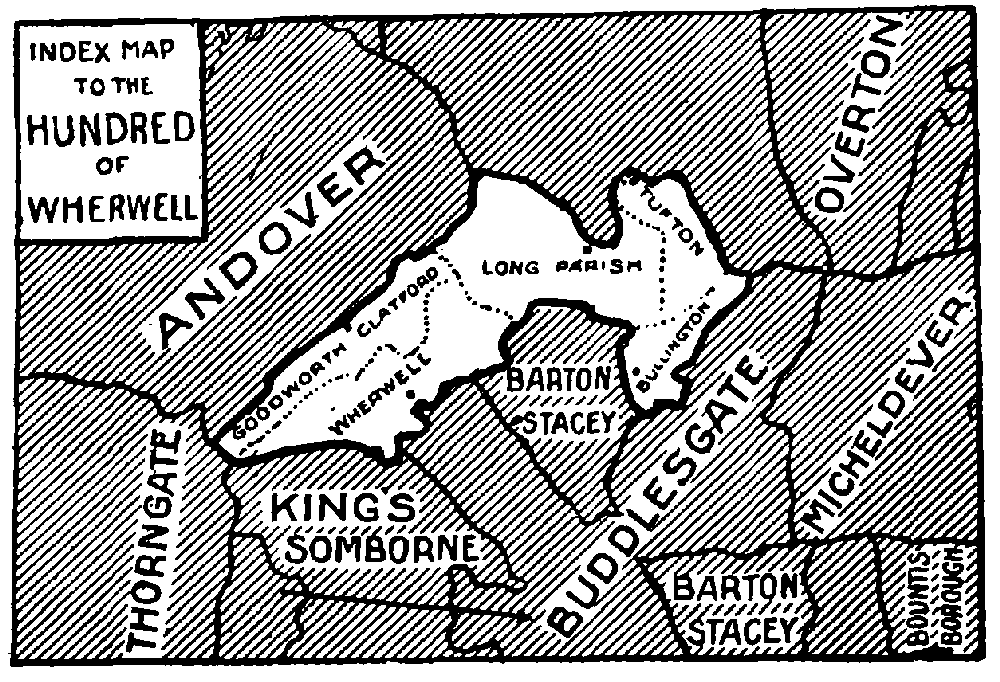A History of the County of Hampshire: Volume 4. Originally published by Victoria County History, London, 1911.
This free content was digitised by double rekeying. All rights reserved.
'The hundred of Wherwell', in A History of the County of Hampshire: Volume 4, ed. William Page (London, 1911), British History Online https://prod.british-history.ac.uk/vch/hants/vol4/pp400-401 [accessed 23 April 2025].
'The hundred of Wherwell', in A History of the County of Hampshire: Volume 4. Edited by William Page (London, 1911), British History Online, accessed April 23, 2025, https://prod.british-history.ac.uk/vch/hants/vol4/pp400-401.
"The hundred of Wherwell". A History of the County of Hampshire: Volume 4. Ed. William Page (London, 1911), British History Online. Web. 23 April 2025. https://prod.british-history.ac.uk/vch/hants/vol4/pp400-401.
THE HUNDRED OF WHERWELL
containing the parishes of Bullington; Goodworth Clatford; Longparish; Tufton or Tuckington; Wherwell with Westover
The above list represents the extent of the hundred in 1831. (fn. 1) Between 1831 and 1841 the following changes were made. Abbotts Ann, of which only the tithing of Little Ann had been always reckoned in Wherwell Hundred, was wholly transferred from Andover Hundred (q.v.) thither. Chilbolton, formerly in Buddlesgate Hundred, was added to Wherwell, while Tufton was moved from Wherwell to Whitchurch Hundred.
To Welford Hundred of Domesday Book—the Wherwell Hundred of a later date—six manors are assigned:—Wherwell, Tufton, Goodworth, Little Ann, Middleton (Longparish) and Bullington. All these were then held by Wherwell Abbey and had been in the Confessor's day, when the total assessment of the six manors was 67 hides as against 37 hides 3⅓ virgates at the later date. (fn. 2) Fullerton in Wherwell, the only manor in any of the parishes of Wherwell Hundred which the house of Elfrida's foundation did not possess, was at the great Survey counted as in the hundred of King's Somborne, and was then, as it remained, in the hands of Hyde Abbey. Little Ann, though severed from the rest of the Wherwell manors, is still included in this hundred; it is treated, however, as in that of Andover with its parish of Abbotts Ann. (fn. 3)

Index Map to the Hundred of Wherwell
The abbey was thus paramount in the hundred. By a grant of King John it was quit for ever of all shires and hundreds, suits of shires and hundreds, aids of sheriffs, reeves and bailiffs and plaints and exactions to them appertaining. (fn. 4) This comprehensive charter, which included also the grant of a fair at Wherwell, was more than once confirmed.
Harewood Forest, to-day one of the largest tracts of woodland in this part of the shire, lies wholly within the hundred. It belonged to the community at Wherwell, and in 1378 the abbess, Cecily de Lavyngtone, received confirmation of a reputed charter of King Alfred, giving the wood to her monastery, which in Alfred's day had, unfortunately, still a century to wait for its foundation. (fn. 5) It was doubtless on the strength of this same charter that thirty years previously the then abbess had petitioned the king against his forest servants. Alfred son of Osgar, late Earl of Devon, she said, had founded the abbey and given Harewood to the abbess and her nuns. The wood had ever been found to be without any forest and had been held peaceably without interference; but now the ministers of Chute Forest, asserting the wood to be royal demesne, had attached it to the forest and put their officers therein, preventing the abbess from hunting and taking her profits. (fn. 6) This petition was scarcely well founded, for in 1296 the abbess then in office had been licensed to fell and to sell 60 acres of underwood in her wood of Harewood, which was within the metes of the forest of Chute, on condition that she forthwith inclosed the wood with a dike and hedge so that the underwood might grow again. (fn. 7)
Claim of the right to chattels of fugitives in the hundred of 'Mestowe' (fn. 8) by the religious of Wherwell led to a lawsuit in the reign of Richard II. One Henry Harold had killed his wife Isabel at Wherwell within the hundred and fled to the church there. The abbess asserted her right, and the murderer's belongings to the value of £35 4s. 8d. were seized by her reeve. The matter went to the King's Bench, where judgement was given for the abbess, but was not delivered because of a difference of opinion among the justices. The abbess, therefore, petitioned the king, who by letters patent granted her the disputed privilege during his life and insured her against molestation for the sum in question. (fn. 9)
When the Dissolution bereft the nuns of church and lands the Lords De La Warr became lords of the hundred as of the manors within it. And so they continued—holding their courts, no doubt, at 'Mustwood,' 'the litle house to keepe Courts and laweday in' (fn. 10) —until the great sale of 1695 that transferred the estates to Edmond Boulter of London.